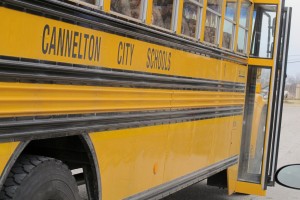For Indiana’s Smallest Districts, Decision To Consolidate Is More Than Financial

Kyle Stokes / StateImpact Indiana
Cannelton City Schools superintendent Al Sibbitt drives down the town's main drag, pointing out shuttered stores and businesses.
Over the past decade, academics and political leaders have delivered a consistent message to Indiana’s smallest school districts: If possible, consolidate with a nearby district.
Recent Ball State research says half of the state’s school districts could reduce costs through a merger. Yet only a handful of schools have actually done it — in part because pressing financial need sometimes isn’t enough to drive consolidation.
Halfway between Louisville and Evansville on the Ohio River are two small cities: Tiny Tell City, Ind., and the even tinier Cannelton. Cannelton’s only three miles upstream from Tell City — but it can seem like it’s worlds apart.
“Here’s some old buildings, just sitting here, empty,” says Cannelton City Schools superintendent Al Sibbitt as he drives down Washington Street.
- Should Very Small School Corporations Still Exist?StateImpact Indiana’s Kyle Stokes explains why pressing financial need sometimes isn’t enough to drive small districts to consolidate.Download
‘I feel like we just drove into the big city’
At one time, Cannelton had nine taverns. Today, the town has three. There are a few open storefronts, but just as many crumbling buildings.
The decline of the town has hit Sibbitt’s schools, too. Vacant properties mean fewer property tax dollars for his budget. But up the road, it’s a different story — it doesn’t take long to see that as Sibbitt drives up Highway 66 into Tell City. On the Tell City side of the town line, there’s a Walmart.
Tell City is far from affluent, but it does have a bigger property tax base.
“They have several banks, shopping centers,” says Sibbitt. “They have a much higher assessed valuation per pupil than Cannelton has.”
Tell City’s school district is bigger with 1,500 kids. Contrast that with Cannelton’s enrollment — it’s shrinking and is now under 250 students. Two small school corporations, just three miles apart, seems like a perfect match for a district merger. But Sibbitt says Cannelton’s not interested — no matter how uncertain the district’s future might be.
“Should Cannelton be a school corporation financially?” Sibbitt asks. “Probably not. But should it be a school corporation that best serves the kids that live here? Yes.”
Why District Consolidation Makes Financial Sense
Michael Hicks directs the Center for Business and Economic Research at Ball State. He’s also the son of a Cannelton High School graduate and still has family in Tell City.
Still, Hicks says it tends to costs more to educate one child in Cannelton as it would to educate that same child in a bigger district. And it’s not just Cannelton taxpayers footing that extra cost: Most of a school’s budget comes from state dollars. Hicks says that makes the added costs of running a small district as much an issue for taxpayers in Carmel or Crown Point as it is for taxpayers in Cannelton.“If all these costs were borne locally, these consolidations would occur in short order, because otherwise Cannelton and Tell City couldn’t afford to educate their children,” says Hicks.
Hicks released research last month repeating a refrain former Gov. Mitch Daniels delivered in a 2007 report: Indiana school districts with fewer than 2,000 — that’s half of the state’s school corporations — could save money by merging with a neighboring district.
Why Small Schools Say Consolidation Isn’t An Option
Back in Cannelton, Sibbitt knows a larger corporation could educate a student in his district for less — but he’s not as sure a larger district could teach that student better.

Kyle Stokes / StateImpact Indiana
Cannelton City Schools superintendent Al Sibbitt talks to a student in the hallway. He says educating a kid from Cannelton is different than educating a kid in another Indiana school district.
“They think, ‘Okay, a kid’s a kid.’ A kid in Cannelton’s the same as a kid in Carmel,” says Sibbitt. “Bulls—. Pardon my language.”
Sibbitt says Cannelton families like the small class sizes. They like that their kids can participate in athletics — something they’re not going to get in Tell City.
On top of that, he’s unsure Tell City school leaders are eager to absorb Cannelton’s outstanding debts … to say nothing of the $615,000 in district funds the Indiana Attorney General says Cannelton’s former superintendent misspent.
There are lots of local politics at play, says Ball State’s Hicks — but none of it is necessarily a dealbreaker.
“A lot of those problems are tractable problems, but they’re going to require technical assistance to get past them,” he says.
The biggest problems with mergers are often in the fine print: How to equalize pay schedules and quality disparities between schools. If the state’s political leaders want to nudge small school corporations to merge, Hicks says they should offer money and manpower to help.
Editor’s note: This story is from former StateImpact Indiana reporter Kyle Stokes, who left last month for KPLU in Seattle. You can read his farewell post here.
Podcast: Play in new window | Download

